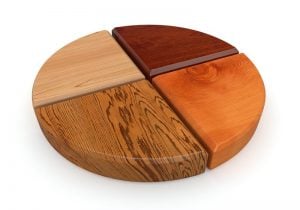
While that might be true from a certain point of view, musicians know that instruments come alive in their hands. Each instrument has a unique voice and feeling, and two are rarely the same—even if they might look alike.
Every part of an instrument matters. Strings matter, the hardware matters, the type of paint matters. Above all, the wood matters. The type of wood, along with how it is treated in the factory, will determine what the instrument looks, sounds, and plays like.
What types of woods are used for guitars?
Not all woods are suitable for use in all parts of a guitar. Spruce, for example, is often used for tops in acoustic guitars (“spruce top”) but is not an ideal material for electric instruments. Each of the main guitar tonewoods has its own place and is chosen for its particular characteristics.
To qualify as one of the best wood for guitars, a type of wood must be strong enough to hold up structurally but also have the tonal properties that a luthier is looking for for a particular project. As such, each project demands its own approach.
Maple

Maple is a very hard type of wood with good tonal qualities and good sustain. Guitar necks are traditionally made from the dense wood of maple, in part because of its strength, and in part, because the material can highlight and amplify the wood in the body. Maple is also often used as a top for the guitar body, partly because it is beautiful (think flame or quilted maple tops), and partly because it can give a bright sound that would otherwise be murky.
Mahogany
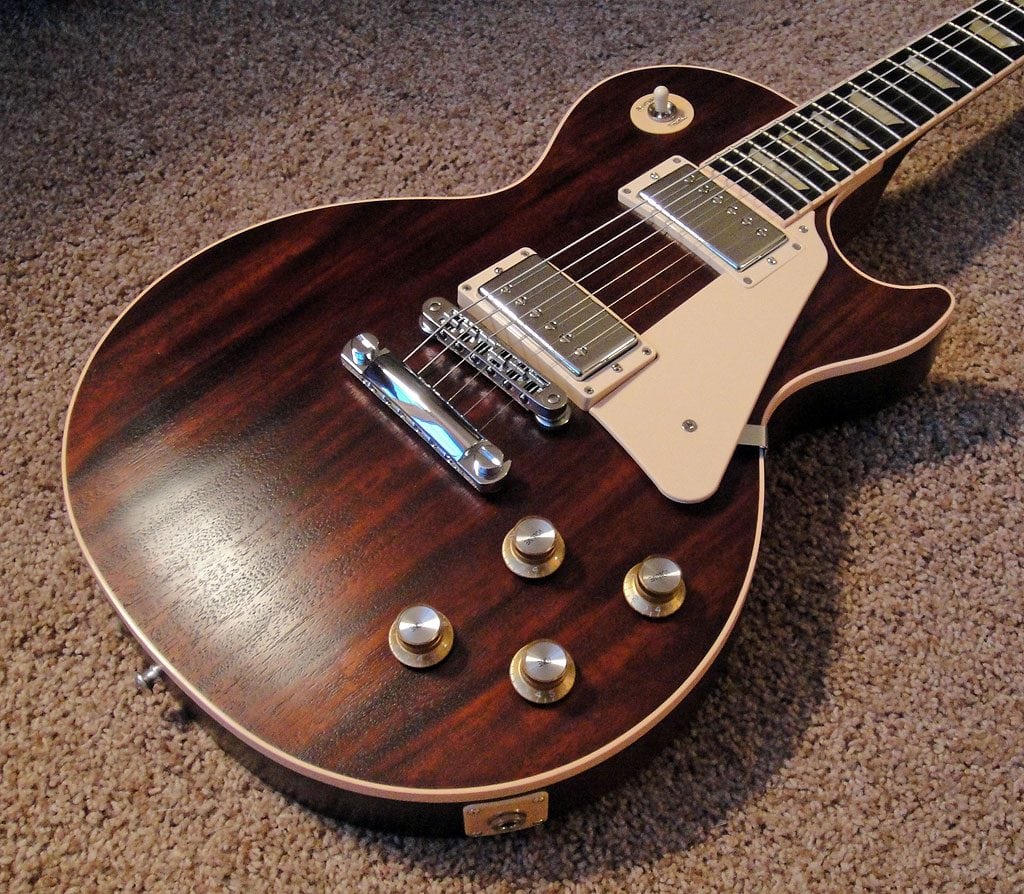
Many guitar and bass bodies are made from Mahogany. There are 49 types of Mahogany, but many are practically extinct because of the wood’s popularity for furniture and musical instruments, and the types used today are not the same as the Mahogany used in guitars in the 1940s or 1950s. Mahogany gives a warm timbre with a lot of bottom end. Les Paul type guitars often combine a mahogany body wood with a maple top for a total that is balanced overall.
Basswood
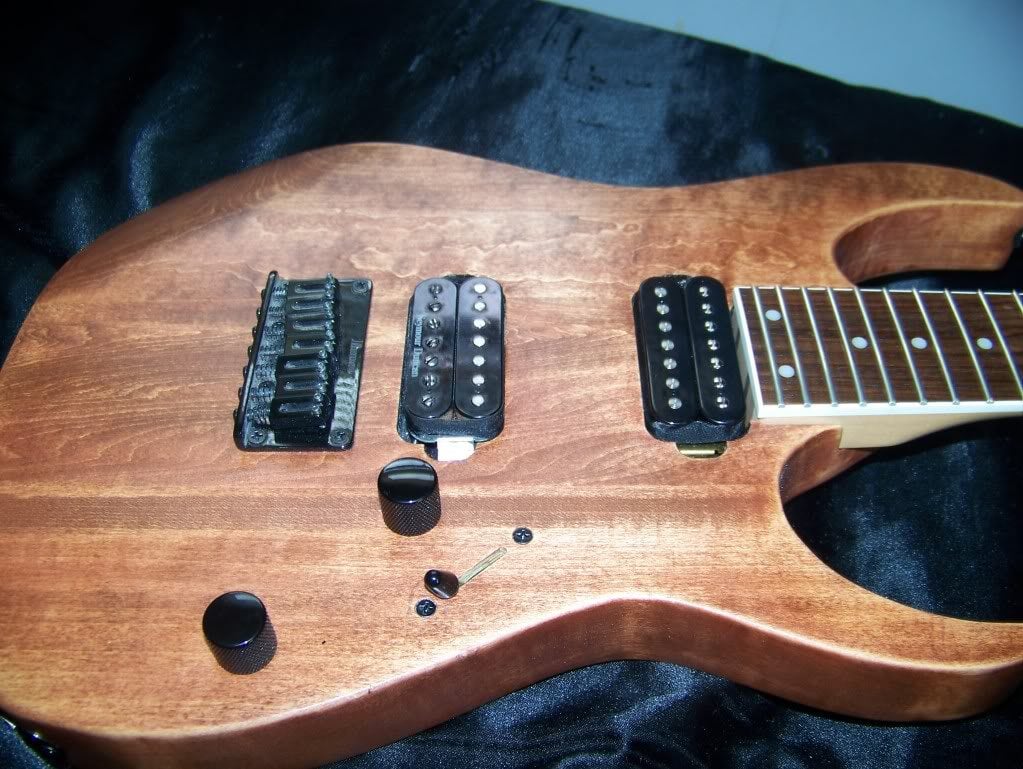
Basswood comes from Linden trees, and it is soft and easy to work with. A side effect of being soft is that it also dents easily. Because it doesn’t have much of a grain or color, it’s most commonly used on instruments that have an opaque paint-job, though this isn’t always the case (as in the photo above). Basswood has a warm, balanced sound with great mid-range and good sustain.
Alder
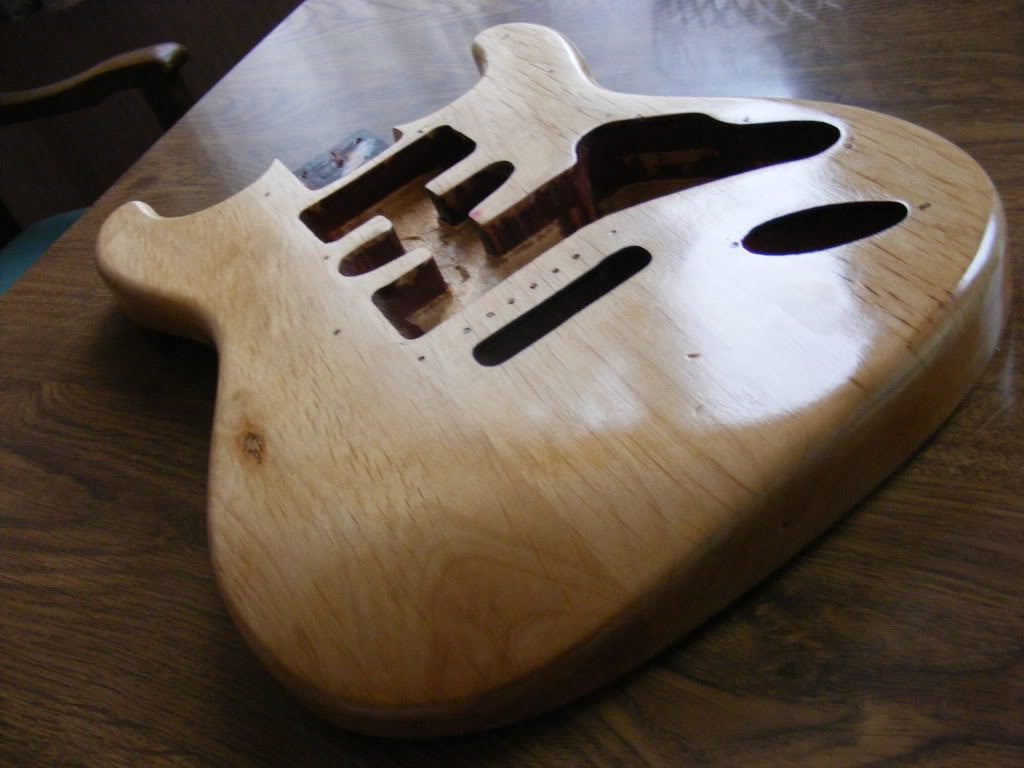
Alder used to be very popular in the 1950s and 1960s, and many Fender guitars from that era are made from Alder. Today it is a bit more expensive of a wood, relatively, and isn’t as common. It is lightweight, has beautiful grain patterns, and gives a warm sound with plenty of highs. An instrument made from Alder is likely to have less midrange and bass than instruments made from other types of wood.
Swamp Ash
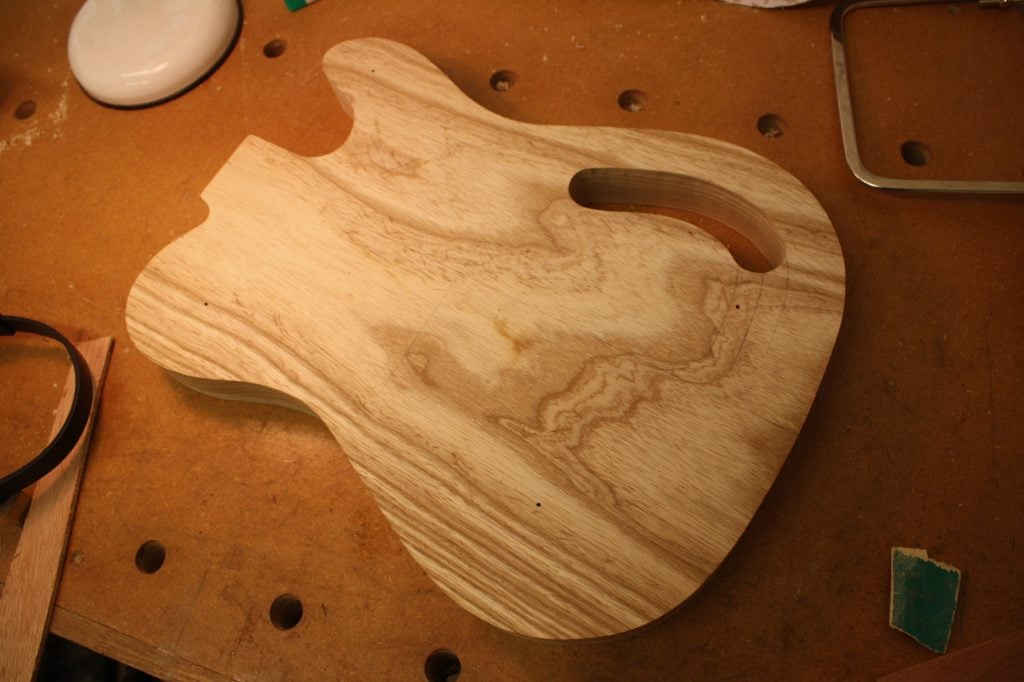
Many American guitar factories use Swamp Ash because the wood is lightweight, pretty, and has a pleasant timbre. Swamp Ash has good sustain, firm bass tones, bite in the midrange, and airy highs.
Other Popular Guitar Woods
Other popular wood types include Korina, which was made popular by Gibson in the late 1950s. It is beautiful yet light and gives a warm and balanced sound with good sustain.
Japanese Ash isn’t really related to any other form of Ash, but it looks similar. This is an expensive guitar wood with bright highs and midrange, good bass, and great sustain.
American Tulipwood (Poplar), Wenge, Phoenix, Paulownia, and Agathis are other woods often used in guitar bodies, each with its own specific tonal qualities.
Besides the type of wood, individual pieces or blanks each have their own unique characteristics in terms of feel and tone. It depends on where the tree grew, how quickly it grew, and how the wood was treated once the tree was cut down.
Fretboards matter
The material in the neck and fretboard also matters. Some guitars have both neck and fretboard in maple, and they will typically have a bright and open sound. Rosewood has traditionally been used for fretboards, usually combined with a maple neck wood, because it is a hardy and oily wood that can stand up to extensive human contact. Rosewood will give a darker tone than maple alone.
Later years have seen restrictions in Brazilian Rosewood import and usage, and other materials are becoming popular instead. These days, many luthiers have started using woods like Pau Ferro and Cocobolo instead of rosewood, with good results.
Ebony is a beautiful and very hard wood popular for fingerboards, though it is not seen as common because it is both rare and expensive. Ebony is especially popular on fretless guitars, where it is more durable than softer materials that are easily worn down by the strings.
Has the wood used in guitar building changed over time?
There are differences between the types of wood used in many old guitars compared to what today’s luthiers use, but whether the sound is better or worse is subjective.
Some types of wood that were commonly used in the 1950s are close to extinct today, and can no longer be used for mass production. For instance, import and usage are restricted for certain types of Mahogany, Rosewood, and Ebony, and large guitar manufacturers in the US have been raided by the justice department on suspicion of using illegal materials.
Are all guitars made from wood?
There are guitar manufacturers who don’t use wood. Some instruments are made from Aluminum, and some use Aluminum for the necks and fretboards. Others use Carbon Fiber, and others yet take another path away from traditional tone woods. Danelectro, for instance, makes a frame out of Poplar and cover it in Masonite.
Each instrument is different—that’s part of what makes them so great. You might have to try many before you find one with a voice that resonates with you.
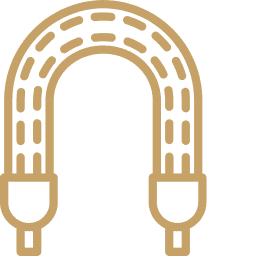






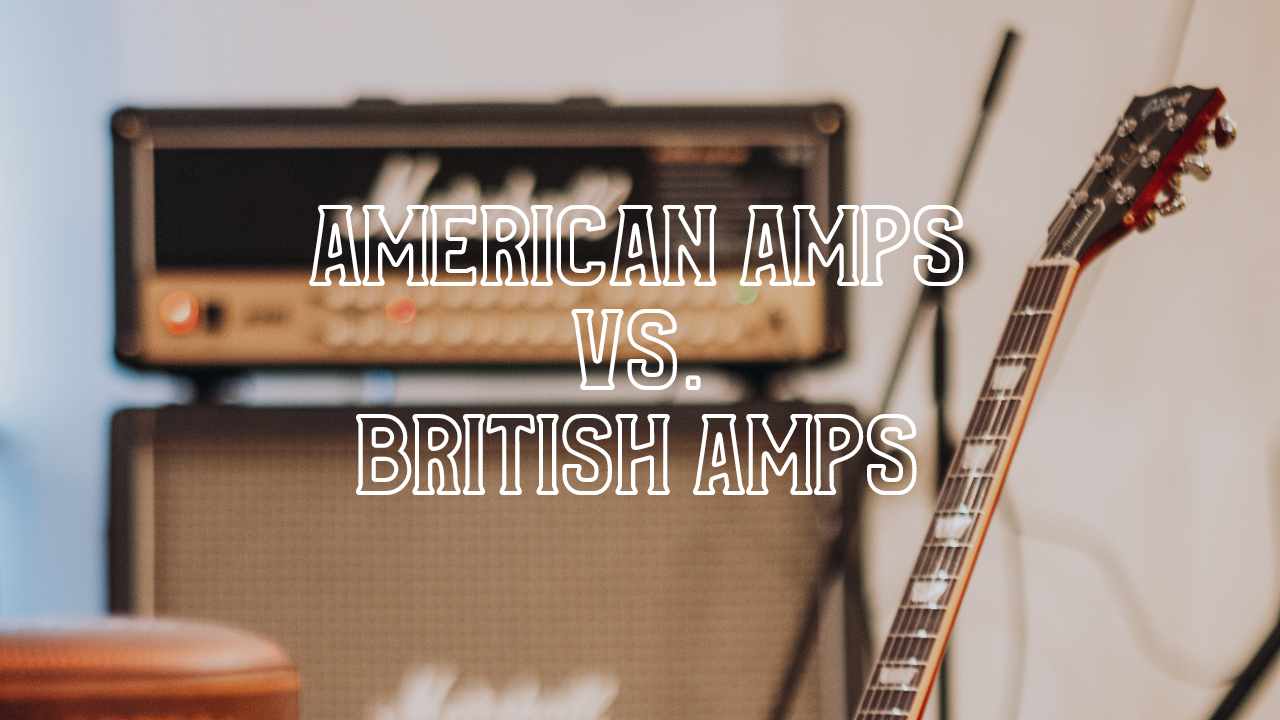
28 Responses
Strange that rosewood was not listed as one of the best woods in making guitar bodies!
I have a late1700’s-early1800’s chest of drawers I rescued from a 200 year old barn that a luthier friend of mine wants to use to make a guitar. He seems to be most interested in the side panels and the drawer bottoms, which look like Tulip Poplar to me, the rest of the parts I do not know. His interest is that this has been in a dirt floor barn, which did rot the legs off, but there are no cracks or warping in any of the wood. He says it is “old growth” wood. Do you think this is a worthwhile use? My plan was to repair the legs. But he said if its only going to be worth 1,000.00, lets use it for a guitar.
If you don’t have any other plans for it, and somebody else is willing to do the work for you—why not?
Get some other wood for the draws/sides and sell him the original bits.
In ’78 bought a 1960 Fender Jazzmaster, custom colour, maple/jamaican rosewood slab frtbrd which was banned later on, alder or ash body (cant remember). The pickups were mellow and the tone from the rosewd was lovelly thru my 180w Super Twin Fender. This gave me a great understanding of wood tonality as i played many other guitars too. The guiatrs i have now 2 x ’62 Strat reissues (both of course rswd slab) MIJ and CIJ, and a ’57 Strat maple neck one peice CIJ, plus some others.
My point is, the rosewood fretbrds are tonally distinct from the maple by a large margin, and its not so much the Basewood bodied ’62s vs ash/alder ’57.
Since owning the original ’60 Jazzmaster (neck date 9/60) i’ve always known to play a guitar unplugged/acoustically for its tone/sound quality because basically this is whats amplified.
One other little tid-bit i have noticed, USA pickups relate/are wound to amplifying the steel of the strings, where Japanese pups relate/wound to the tone given off the string which is why theres ‘the difference’ between the two ie USA are more ‘ka-ching/chimey’; also the denser Ash body used by both plays on tone.
N.B. You can brighten tone with amp types and pedals but you cant get more neck/body tone if it isnt there.
Very informative, thank you.
I was recently reading an ad for a new Martin acoustic/electric guitar and the ad stated the side and back were made of mutenye wood. I am guessing, based on the name, this an African wood of some sort?? Could you enlighten me if you know anything about this wood?
I’m afraid I don’t have any info on it.
I just bought the Martin DC-13E, which is mutenye. Various sources have said it’s similar to ovangkol, which sits somewhere on the spectrum between rosewood and mahogany; some say it’s more like rosewood, some say it’s more even in tone. What I can say from my experience (bought the guitar on 6/1/2019) is that the mutenye guitar I bought has richer overtones than the sapele (mahogany-like) D-12E and the sycamore D-16E I compared it to. My wife described it as warmer than the sapele D-12E.
dude just google it
Close your eyes and use your ears. It’s sometimes near implorable, I mean impossible, to tell a wood from a carbon or a soft wood from a hard wood. Any virtuoso can make it very hard for you to tell if it’s a $5000.00 fine wood guitar or a $500.00 blue plate. Same with “audiophile” home speakers. Better woods last longer. Tone is subjective. Tons of tone is even moreso. Jus’ call me morose.
I’m almost 100% certain that I own the guitar used in the picture for Basswood. It is clearly mislabeled underneath, stated to be an Ibanez RG8, when it is in fact a 7 string. I purchased the exact same guitar from a private seller off EBay back in 2010 or so. My guess is that it’s an Ibanez RG7321 that someone got ahold of, stripped the finish and stained it. It has a Seymour Duncan JB-7 in the Bridge and I can’t recall the neck pickup at this time. Most likely, just what it came with. If I could see the guitar in it’s entirety I could probably confirm this. The grain patterns just above the pickups is almost undeniable and as we all know, no two cuts of wood are the same. Overall, the guitar was pretty mediocre, what you’d come to expect from a low end guitar. Never would’ve expected to see it on a guide to tonewood.
Good eye! It well might be. Was just a royalty-free picture we found that showed off the grain of basswood the best.
Read it again….it say it is an RG7 (unless it has been corrected!?)
Has anyone ever used redwood to build a guitar.
I’m not positive, I do know that cutting down redwoods is generally frowned upon though…
I’ve used redwood. I built an axe shaped guitar. I call it “The Hippie Killer”.
Wood is surely a major determining factor to the tone of a guitar.
That mahogany Les Paul body is the most beautiful guitar I’ve ever seen!
I agree
i am purchasing a acoustic-electric guitar i got up to two guitars but the problem is i dont know much about woods which is better to buy a “select mahgony” or “linden wood” for back and sides
i am doing research project this year and all of this information about the electric guitar is very useful. if you could please email me so i could have an interview with you about some more questions that would be great. thanks 🙂
My latest archtop build was made with flamed myrtlewood back and sides. Similar sound to maple but more! Love it!
I am 60 years old. I want a guitar (acoustic). I have decided on to retrain myself towards finger pickin style. I am researching knowledge and the tonal properties of the wood / tonal qualitites. I have very small (5.1).
My hands are small. Neck demensions are very important towards please let me be trained so i can determine neck width and shape for my guitar
You may want a parlor guitar, at least for start. My advice, go buy a first act acoustic from Walmart- about $46 bucks, $36 sometimes, and learn some chords. Then you’ll be able to walk into any guitar store and tell them exactly what you want
Nah, CoW doesn’t make a significant difference in the tone of a solidbody electric guitar with pick-ups only. Although, CoW can affect intonation in the fretboard. -Jordan G.
This couldn’t be more wrong. I’ve been building guitars for almost a decade and I can tell you, wood makes a big difference in the overall tone of a guitar. Sure, it isn’t the single most important factor, but great guitars are all about the details, and wood is far more than a detail.
Having constructed many electric guitars out of various types of wood I can say that in my experience it makes a huge difference.
I agree totally with wood having a lot to do with tone and the different types of wood for different parts of the guitar. How anyone could think otherwise!? An ongoing debate. Why? Just knocking on different types of wood can demonstrate that….or strum a guitar, especially an electric not plugged in and hold it against the wall. ( now you will have some debating on if the wall is sheet rock or wood, lol) I have never built a guitar but I believe nature is the teacher on this one. A plexiglas/acrylic type of guitar looks very cool but sounds bad. Take the exact dimensions, cavities, all the electronics, parts, etc. of that guitar and put it into a wood model….and other different types of wood, blah, blah, blah….all seems common sense to me.